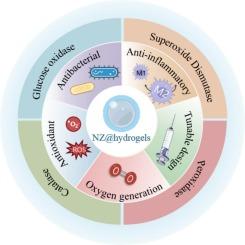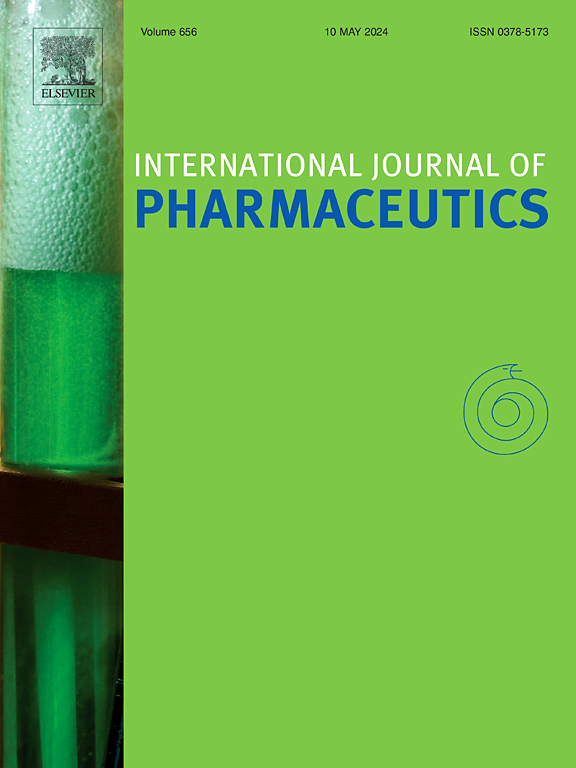Multifunctional nanozyme-embedded hydrogels for advanced diabetic wound management
IF 5.2
2区 医学
Q1 PHARMACOLOGY & PHARMACY
引用次数: 0
Abstract
Diabetes mellitus imposes a substantial global healthcare burden due to its chronic progression and associated complications. Diabetic wound healing is severely compromised by hyperglycemia-induced pathological alterations, including osmotic imbalance, bacterial proliferation, and impaired tissue regeneration. Critically, excessive reactive oxygen species (ROS) in the wound microenvironment perpetuate inflammation, degrade extracellular matrix (ECM), and delay healing, necessitating advanced therapeutic dressings. Hydrogels emerge as ideal candidates owing to their high hydration capacity, biocompatibility, and structural mimicry of native ECM. Nanozymes (NZs)—nanomaterials with enzyme-mimetic catalytic activities (e.g., superoxide dismutase, catalase)—offer superior stability and catalytic efficiency compared to natural enzymes. Integrating NZs into hydrogels yields multifunctional nanozyme-embedded hydrogels (NZ@hydrogels) that synergistically combine ROS scavenging, antimicrobial action, and pro-healing functions. This review systematically analyzes diverse NZ@hydrogel systems leveraging enzymatic mechanisms (e.g., glucose oxidase-like, peroxidase-like activities) for diabetic wound therapy, emphasizing their roles in modulating inflammatory responses, hypoxia alleviation, and angiogenesis promotion. Current translational challenges, including biocompatibility optimization, long-term biosafety assessment, and scalable manufacturing, are critically evaluated. Future perspectives focus on accelerating clinical adoption through advanced material design and rigorous preclinical validation, aiming to stimulate transformative research in precision wound management.

多功能纳米酶包埋水凝胶用于晚期糖尿病伤口处理。
糖尿病由于其慢性进展和相关并发症,给全球医疗保健造成了巨大负担。糖尿病伤口愈合受到高血糖引起的病理改变的严重损害,包括渗透失衡、细菌增殖和组织再生受损。关键是,伤口微环境中过多的活性氧(ROS)会使炎症持续存在,降解细胞外基质(ECM),并延迟愈合,因此需要先进的治疗敷料。水凝胶由于其高水合能力、生物相容性和天然ECM的结构模仿而成为理想的候选者。纳米酶(NZs)-具有模拟酶催化活性的纳米材料(例如,超氧化物歧化酶,过氧化氢酶)-与天然酶相比具有优越的稳定性和催化效率。将NZs整合到水凝胶中产生多功能纳米酶包埋水凝胶(NZ@hydrogels),协同结合ROS清除,抗菌作用和促愈合功能。这篇综述系统地分析了利用酶机制(如葡萄糖氧化酶样,过氧化物酶样活性)治疗糖尿病伤口的各种NZ@hydrogel系统,强调了它们在调节炎症反应,减轻缺氧和促进血管生成中的作用。当前的转化挑战,包括生物相容性优化、长期生物安全评估和可扩展的制造,都进行了严格的评估。未来的展望重点是通过先进的材料设计和严格的临床前验证来加速临床应用,旨在刺激精确伤口管理的变革性研究。
本文章由计算机程序翻译,如有差异,请以英文原文为准。
求助全文
约1分钟内获得全文
求助全文
来源期刊
CiteScore
10.70
自引率
8.60%
发文量
951
审稿时长
72 days
期刊介绍:
The International Journal of Pharmaceutics is the third most cited journal in the "Pharmacy & Pharmacology" category out of 366 journals, being the true home for pharmaceutical scientists concerned with the physical, chemical and biological properties of devices and delivery systems for drugs, vaccines and biologicals, including their design, manufacture and evaluation. This includes evaluation of the properties of drugs, excipients such as surfactants and polymers and novel materials. The journal has special sections on pharmaceutical nanotechnology and personalized medicines, and publishes research papers, reviews, commentaries and letters to the editor as well as special issues.

 求助内容:
求助内容: 应助结果提醒方式:
应助结果提醒方式:


